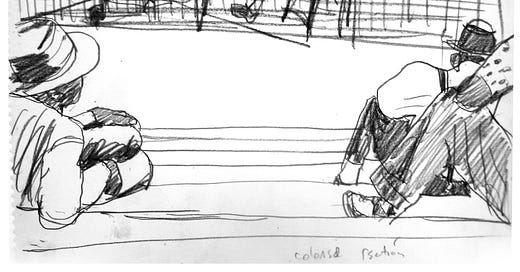Robert Weaver: Raw Real Reportage
In 1962, illustrator Robert Weaver sketched baseball’s spring training like no other artist had before.

Illustrator Robert Weaver (1924-1994) was ahead of his time. Aware that magazine illustration in the 1950’s had become stilted and somewhat formulaic, Weaver brought a more socially engaged approach to his storytelling, and ideas and values from fine art to his picture making.
When art directors for Fortune, Cosmopolitan and other publications sought out his work, they knew that they’d be hiring a visual journalist. In 1962, Sports Illustrated sent Weaver to cover Major League Baseball’s spring training in Florida, where he created over 40 on-the-spot drawings and six paintings. His drawings capture the timeless qualities of baseball players at rest and at bat. But he also drew baseball fans, hot dog vendors, and African Americans in the segregated section of a park.

Weaver’s drawings are confident, honest and innovative. His compositions display a layered complexity of scenes with a casual touch. While some may consider these sketches as mere preparatory work for final illustrations, they stand on their own as elegantly constructed narratives.
Weaver said the secret to his approach was “to be an accepted, unobtrusive presence,” and be embedded in the scene “in the interest of credibility.”
The significance of Weaver’s methodology and activism changed people’s perception of illustration. His influence was clearly reflected in the magazines, books and advertisements that would follow. Commercial art that was typically labeled “superficial” was becoming more daring and participatory.
Much of Robert Weaver’s final years were spent as an influential, yet some say irascible, teacher at the School of Visual Arts and at Syracuse University.
More about Robert Weaver:
The Robert Weaver Collection is in the D.B. Dowd Modern Graphic History Library at Washington University in St. Louis, Missouri. Daniel Zalkus visited the Weaver Collection and took photos for his article in Illustration Age.
Leif Peng’s post ‘The Incursion of the Avant Garde: Rober Weaver’ on his Today’s Inspiration blog provides some context to Weaver's other magazine work.
Jaleen Grove wrote an interesting essay called “Towards Illustration Theory: Harold Rosenberg, Robert Weaver, and the “Action Illustrator” about Weaver’s significance within the fine art world.
Find more Robert Weaver images on Pinterest.







Wow, very impressive! I love his work, and thanks for introduction!
Thanks for sharing Weavers work!